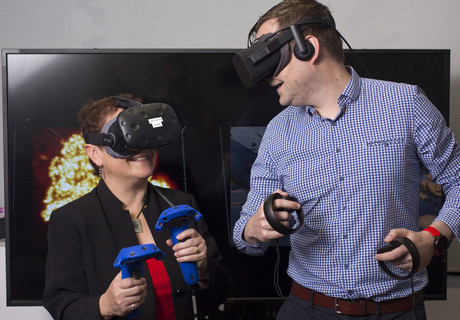VR allows scientists to 'walk' together through cancer cells

Virtual reality (VR) technology designed by the ARC Centre of Excellence in Convergent Bio-Nano Science & Technology (CBNS) is allowing multiple scientists to see inside a human cell at the same time, giving researchers a 3D tool to improve doctor interaction and help analyse how cancer drugs work.
The technology is the result of a major initiative called Journey to the Centre of the Cell, which combines scientific data, microscopy images and animation to create a virtual world of cells and blood vessels that can be seen through headsets. Professor John McGhee and Professor Maria Kavallaris, both investigators at CBNS, are collaborating on the project.
“I saw we could do so much more with VR than selling products and superheroes,” explained Professor McGhee. “We have amazing gaming technology and we can use it to benefit patients and specialists. The inner workings of the body can often get lost in specialist data and this makes the process democratic.”
Until now, Professor McGhee’s work involved single VR headsets, with one person moving around in the data. But new technology means multiple users from different parts of the world can walk inside the ‘landscape’ of the cell at the same time.
“We can have multiple scientists logging in at once with users able to view the same data,” he said. “This could help researchers ask questions they’ve never thought of.”
Professors McGhee and Kavallaris are focusing on educating researchers on how cells function and the way drugs are internalised by cancer cells. According to Professor McGhee, “Our goal is to be able to see a drug enter into the tumour, so we can highlight the target for chemotherapy or radiotherapy and deploy a drug more accurately.”
Professor Kavallaris, a leading cancer biology researcher and nanomedicine expert, said tracking 3D cells in tumours can show scientists what happens when cells move in real time — information that can be used when looking at the spread of cancer.
“We have never had access to something like this before,” she said. “We hope it will help scientists better understand how and what happens if you interfere with a genetic process and add certain drugs. Eventually it could be a tool to explain to patients and their parents about types of cancer and strategies for treatment.”
The technology is already being trialled on Monash University pharmaceutical science students learning about cancer drug delivery to see if it improves their understanding. The results of the trial, published in the journal Traffic, are looking particularly promising.
“Early testing of this immersive environment indicates a significant improvement in students’ understanding of cellular processes and points to a new future of learning and public engagement,” the study authors wrote. “In addition, we speculate that VR can become a new tool for researchers studying cellular architecture and processes by populating VR models with molecular data.”
Digital twin of the heart helps detect cardiac arrhythmias
A new non-invasive method can locate the origin of premature ventricular contractions (PVC)...
GenAI tool can speed up scientific discovery
The new AI system is an interactive LLM tool which can retrieve useful information from...
AI trained to diagnose lung diseases
The AI model works by examining each video frame to find important features of the lungs and...




